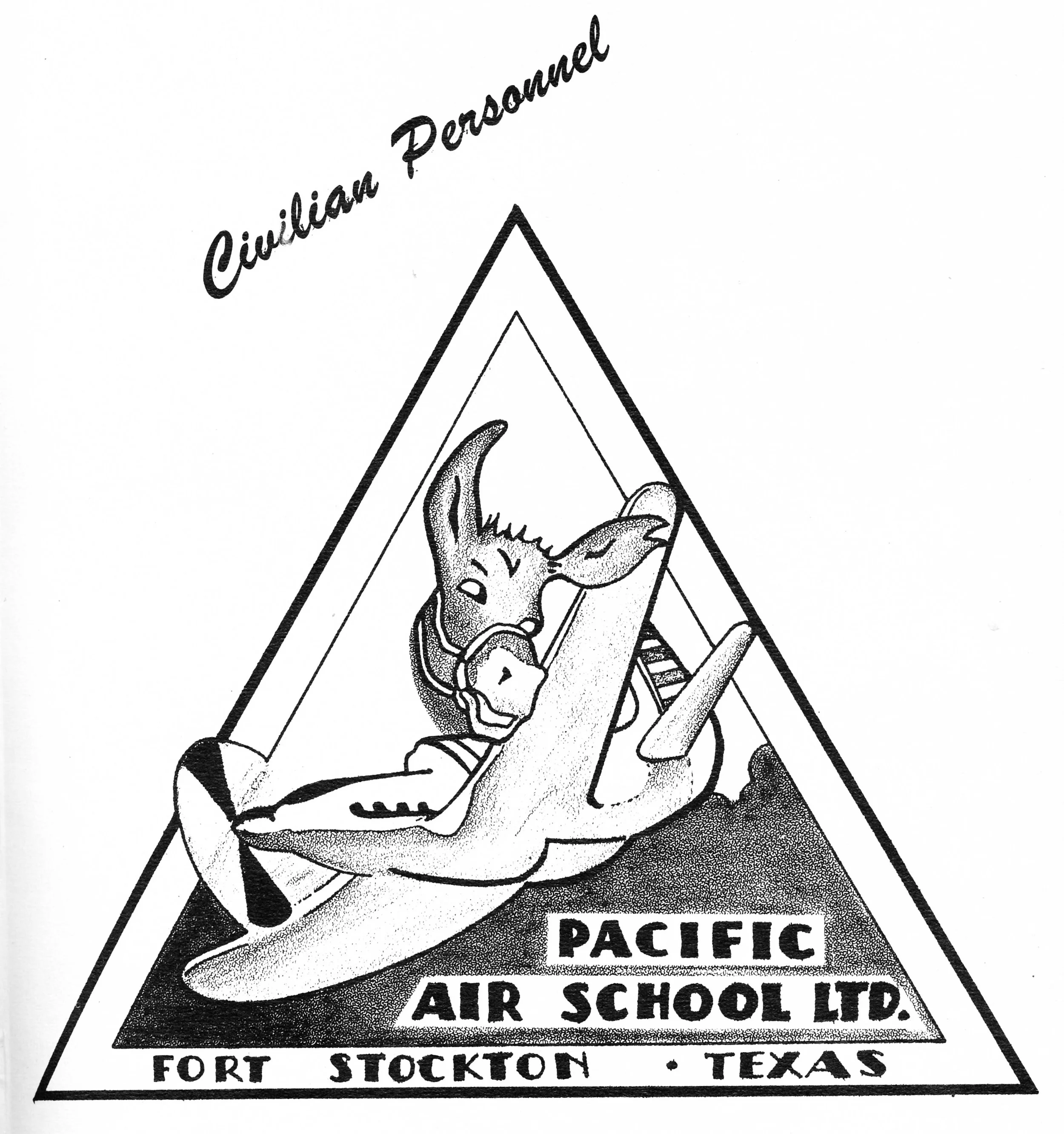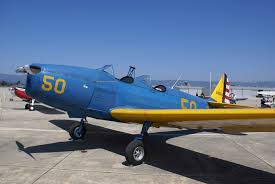Solo, a donkey, was chosen for the Gibbs Field mascot.
Whenever a cadet completed his first solo flight, he had to kiss the real Solo mascot kept at the air base.
Gibbs FielD, Pecos County’s Training Base FOR WW II FightER Pilots
Gibbs Field, and another landing strip (Winfield) just off of I-10 where the old, abandoned hangar remains today.
Gibbs Field was named for Maj. David R. Gibbs, who was killed in the Philippines. Gibbs Field is now the Fort Stockton Airport.
Winfield Hangar was built in 1936 by the WPA. It is an adobe structure with a tin roof that is still standing
Pecos County was chosen because of the number of flying days (clear weather) per year and the unlimited visibility.
The training bases had civilian instructors under the Pacific Air School but military administrators.
North American Aviation T-6 Texan
Fairchild PT-19
The airplanes
North American Aviation T-6 Texan
The best indication of how good a trainer the T-6 Texan was is can be seen by the fact that here we are 40 years into the jet age and there are still countries around the world using the North American T-6 as first-line trainers. As recently as five years ago, major air forces still used it and it is the updating of those air forces which has pumped so many surplus T-6s into the American civilian market.
Compared to the earlier biplane trainers, the Fairchild PT-19 provided a more advanced type of aircraft. Speeds were higher and wing loading more closely approximated that of combat aircraft, with flight characteristics demanding more precision and care. Its virtues were that it was inexpensive, simple to maintain and, most of all, virtually viceless. The PT-19 truly lived up to its nickname, the “Cradle of Heroes”. It was one of a handful of primary trainer designs that were the first stop on a cadet's way to becoming a combat pilot.
These planes were delivered to Gibbs Field by WASPs (Women's Airforce Service Pilots) between 1942-1944. The WASP training base is located in Sweetwater, Texas.
The wide-open spaces and nearly limitless visibility meant that there was not a lot to “run into” out here, but nevertheless there were two deaths recorded while Gibbs Field was open. A student and instructor (Fasanella and Ferguson, shown in the photo above) perished upon attempting a landing. They were immortalized in the Solo yearbook given to all graduating cadets. The open country beckoned pilots to fly over the nearby Sierra Madera to the south, (photo below) including this pair of P-38 Lightnings. Hundreds of fighter pilots received their wings in Pecos County, then were sent to Europe, or the Pacific, for air combat.
A pair of P-38 Lightnings flying over the Sierra Madera just south of Fort Stockton.
Today the old Gibbs Field is the Fort Stockton Airport. It is used for private and commercial aircraft, but not passenger lines. The old control tower with the image of Solo and the beacon light are still standing, reminding visitors of a time when the world was at war.
The old control tower at what was once Gibbs Field.
A History of Gibbs Field by Betty Hargus
Even before America entered into WWII, the Army Air Force had determined that Fort Stockton would be an ideal site for a pilot training facility. It was clearly published in the local papers that the army had been in the Fort Stockton vicinity in 1939 to inspect the town’s airport and to begin negotiations for leasing property to build a training facility. The city agreed to provide electricity, water, gas and telephone services to the site should the War Department decide to assume control of Winfield Airport. By September 14, 1941 the negotiations were complete and the army formally announced that it had signed a fifty-year lease at $1.00 per year on the airport.
In April 1942, the army acting through one of the pilot training contractors totally revised the original plan and now intended to build a complete new airfield on another tract of land northwest of the city. Negotiations were completed to acquire the 1200 acres and closed a deal to provide the land for Pacific Air School LTD, the government – subsidized pilot training contractor. The federal government was to build the facility at a cost of $800,000.00. The news electrified Fort Stockton. The small town had been bypassed by two railroads, but at last the community would have modern transportation. There soon would be 500 cadets on the field with plenty of jobs for the local civilians. This was indeed welcome news to a region that had seen the Great Depression severely diminish national demands for agriculture and petroleum products. Construction began immediately for four hangers, a ten-bed hospital, a mess hall and a recreation center to be built along a dirt runway to accomodate take off and landings of the projected 120 aircraft. Fifty houses were to be built and to provide housing for the balance, the local residents were asked to provide whatever space they had available for military families and civilians working on the field. On June 26, 1942 the facility was considered sufficient to receive it`s first class of student pilots. According to Lt. William Koontz, who was stationed at Gibbs Field, the rush to complete the facility did not impair the attractiveness. Gibbs Field was the most architecturally attractive in the training command. Originally this facility had been planned for a Pacific Airfield in Stafford, Arizona. Texas land with superior terrain and weather conditions were more favorable and the Arizona project was canceled and building plans were transferred to Fort Stockton.
Once again Fort Stockton found itself a full-fledged military town. Local citizens joined businesses in welcoming the cadets by furnishing all the spare rooms available. The Pacific Air School was a tremendous boost to the Fort Stockton economy as it was in a severe slump.
On October 9, 1942 the name of the training school at Fort Stockton was changed form Miller Field to Gibbs Field in honor of Mr. David R. Gibbs, who had been killed in action in the Philippines. The first group of cadets arrived before either their mess hall or barracks were ready. The group was housed in the Community Recreation Building in Rooney Park and fed at the nearby Stockton Hotel. The Stockton Hotel was recently demolished but the community building is still being used today.
During the nine-week primary flying instruction, the cadets would complete ground school along with both dual and solo flight instruction. Upon completion of the initial solo flight the young pilot was required to kiss the field mascot, a miniature mule named Solo. The mule mascot proved to be very popular and its image was included in the field logo, which was designed by Cecil Long Casebier in 1942. According to A. E. Ivy, Gene Riggs, and Albert Bean, the relationship between Gibbs Field and Fort Stockton during war years was always friendly. During the time the field was operational, many marriages took place between the military personnel and Fort Stockton’s eligible young ladies. Among these marriages was dispatcher A.E. Ivy himself.
In late February 1944, not quite two years after the school opened, it was announced that Gibbs Field was soon to be closed. This was because the United States Army Air Force now had as many pilots as was needed. Over five thousand young men completed primary pilot training at Gibbs Field and went on to basic training elsewhere. On March 3, 1944 the class 44-G was the final group of cadets to graduate. After the closing of the field, all of the equipment was offered for sale. After all surplus merchandise was sold, Gibbs Field faded away.
To one man however, the field was too precious to be allowed to die. Bill Hargus, who flew eighty five missions in P-47 Thunderbolts over Europe including D-Day, came back from World War II as a seasoned combat pilot with a love for aviation and a strong belief that West Texas in general and Fort Stockton in particular had much to gain by maintaining Old Gibbs Field as a county aviation center. He became the manager of the Pecos County Airport in 1956. The buildings were in very bad condition with ceilings falling in, walls crumbled and hanger doors buckled, yet the old base was intact. All four hangers were standing, as were the operational buildings, some barracks and a mess hall. Hargus slowly began to rebuild and repair the buildings and their furnishings so Pecos County and Fort Stockton could claim a presence in the aviation era that lay ahead. Largely through his efforts, much of what was once Gibbs Field remains intact. The dirt runways used by the cadets of 1942-1944 are still visible. The old-field is in likelihood now the best preserved of all the historic WWII bases in West Texas.
Bill Hargus was manager of the airport for forty-eight years before his death in November 2004. He was instrumental in having the main East-West runway extended twice to accommodate larger aircraft. During his tenure as airport manager, there was also a paved North-South runway built. Hargus logged more than 30,000 hours flying in more than 60 years as a pilot. Bill was certified in almost every aspect of aviation, including Commercial Day-Night, Multiengine and Instrument ratings along with Certified Flight Instructor and Flight Training and was a Designated Pilot Examiner. He also was certified as an IA-A&P, Inspection Authorization and Airframe & Powerplant, through the Federal Aviation Administration. Bill also held an Ag-certificate for spraying and hunting predators for the ranchers.
Winfield hanger still stands and belongs to Pecos County and is under the care of Pecos County Historical Commission. It is on the Texas Preservation most endangered list at this time.






